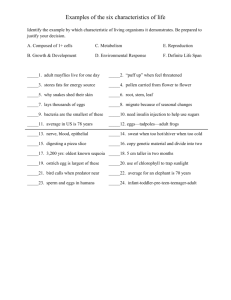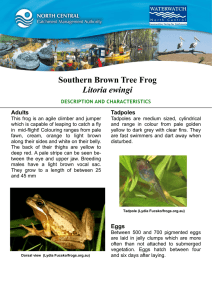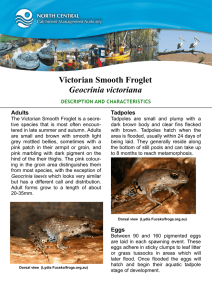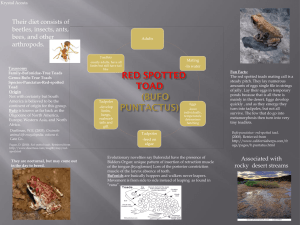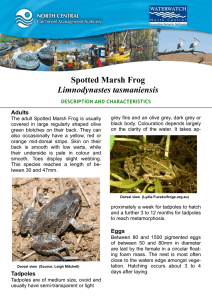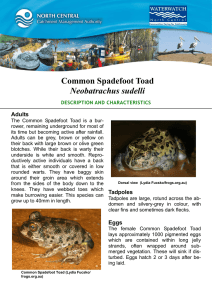Bibrons Toadlet Pseudophryne bibroni Adults
advertisement
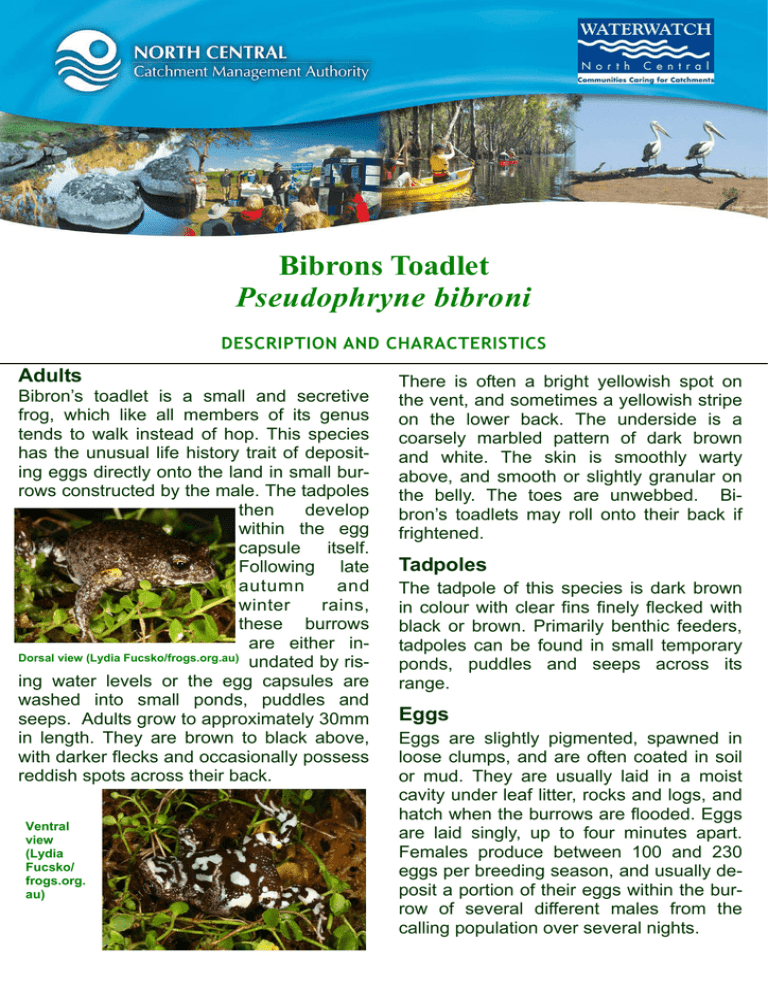
Bibrons Toadlet Pseudophryne bibroni DESCRIPTION AND CHARACTERISTICS Adults Bibron’s toadlet is a small and secretive frog, which like all members of its genus tends to walk instead of hop. This species has the unusual life history trait of depositing eggs directly onto the land in small burrows constructed by the male. The tadpoles then develop within the egg capsule itself. Following late autumn and winter rains, these burrows are either inDorsal view (Lydia Fucsko/frogs.org.au) undated by rising water levels or the egg capsules are washed into small ponds, puddles and seeps. Adults grow to approximately 30mm in length. They are brown to black above, with darker flecks and occasionally possess reddish spots across their back. Ventral view (Lydia Fucsko/ frogs.org. au) There is often a bright yellowish spot on the vent, and sometimes a yellowish stripe on the lower back. The underside is a coarsely marbled pattern of dark brown and white. The skin is smoothly warty above, and smooth or slightly granular on the belly. The toes are unwebbed. Bibron’s toadlets may roll onto their back if frightened. Tadpoles The tadpole of this species is dark brown in colour with clear fins finely flecked with black or brown. Primarily benthic feeders, tadpoles can be found in small temporary ponds, puddles and seeps across its range. Eggs Eggs are slightly pigmented, spawned in loose clumps, and are often coated in soil or mud. They are usually laid in a moist cavity under leaf litter, rocks and logs, and hatch when the burrows are flooded. Eggs are laid singly, up to four minutes apart. Females produce between 100 and 230 eggs per breeding season, and usually deposit a portion of their eggs within the burrow of several different males from the calling population over several nights. LIFE CYCLE AND MATING CALL Male toadlets call from within a nest or burrow in damp soil, or while concealed in damp leaf litter, under rocks or within grass clumps. Their advertisement call is a short harsh grating “cre-ek” repeated every few seconds. Territorial calls consist of an extended rasping note, which descends slightly in tone. Male toadlets call from February to June, and eggs are deposited from April to June. Tadpoles emerge from September through to November. Life History Cycle (Source: www.frogs.org.au) HABITAT AND DISTRIBUTION Bibron’s toadlet is found in dry forest, woodland, heathland and grassland. They are usually solitary unless in breeding aggregations. They shelter under leaf litter and other debris in moist soaks and depressions. Eggs are deposited in damp leaf litter under logs and stones. Hatching occurs when sufficient rains flood the area, washing eggs into ponds where the tadpoles can continue their development. Bibron’s toadlet is found from south-western South Australia, throughout Victoria and up the eastern side of Australia as far as southern Queensland. Victorian Distribution (Source: www.frogs.org.au) IMPORTANCE AND POTENTIAL THREATS Although Bibron’s toadlet was previously considered to be common throughout Victoria, concern is now held for the long-term survival and viability of populations. Once common throughout forests, heathland and grassland across its range, populations of Bibron’s toadlet are now encountered far less frequently. In the past, Bibron’s Toadlet was commonly found within ephemeral pools (which usually dry out each year) and soaks throughout Victoria. Populations of Bibron’s toadlet are now considered by many to be in decline. Prolonged drought is likely to be impacting upon this species, with low autumn and winter rainfall potentially limiting the breeding success of Bibron’s toadlet. Disturbance or loss of temporary pools and soaks used for reproduction is another likely threat to this species. It is also speculated that Chytridiomycosis, a disease caused by the Chytrid fungus, Batrachochytrium dendrobatidis (which has been shown to cause adult mortality in several other frog species) may also be impacting upon Bibron’s toadlet. Bibron’s toadlet has recently been listed as a threatened species on the Victorian Flora and Fauna Guarantee Act 1988. North Central Waterwatch would like to thank and acknowledge Melbourne Water for allowing us to reproduce their materials in the production of this resource.
